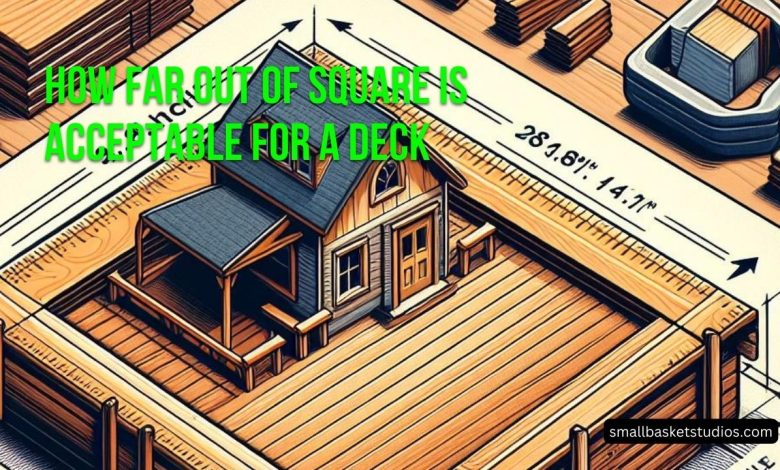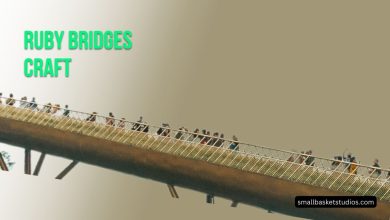How Far Out of Square Is Acceptable for a Deck: Professional Insights

Building a deck is a great way to enhance your outdoor living space and add value to your home. However, constructing a deck requires careful planning and execution to ensure its safety and longevity. One crucial aspect of deck building is ensuring that it is square. A square deck not only looks better, but it also performs better and is safer to use.
Understanding deck squareness is essential to achieving a well-built deck. A square deck means that all four corners are at 90-degree angles, and all sides are equal in length. Achieving perfect squareness is difficult, but it is essential to get as close as possible. Even a small deviation from squareness can cause problems with the deck’s structure, stability, and appearance. In this article, we will explore the importance of square decks, acceptable out of square measurements for decks, factors influencing deck squareness, how to measure deck squareness, rectifying out of square decks, preventing future squareness issues, professional help for deck squareness, and frequently asked questions.
Key Takeaways
- A square deck is crucial for its stability, safety, and appearance.
- An acceptable out of square measurement for decks is approximately 1/8″-1/4″.
- Factors influencing deck squareness include materials, tools, weather, and construction techniques.
Understanding Deck Squareness
When building a deck, it is important to ensure that it is square. A square deck is not only aesthetically pleasing, but it is also structurally sound. If a deck is not square, it can cause problems with the structure, such as uneven weight distribution, which can lead to sagging and even collapse.
To understand deck squareness, it is important to know what it means. A square deck is one where all four corners are at 90-degree angles, and all sides are of equal length. When a deck is not square, it means that the corners are not at 90-degree angles, and the sides are of different lengths.
As per industry standards, a deck is considered square if it is no more than 1/8 inch out of square. This means that the diagonals of the deck should be within 1/8 inch of each other. If the deck is more than 1/8 inch out of square, it can cause problems with the structure, such as uneven weight distribution, which can lead to sagging and even collapse.
To ensure that a deck is square, there are a few things that need to be considered. First, the frame of the deck needs to be square. This means that the corners of the frame need to be at 90-degree angles, and the sides need to be of equal length. The 3-4-5 method is a commonly used method to ensure that the frame is square. This method involves measuring three feet along one side of the frame, four feet along the other side, and then measuring the diagonal distance between the two points. If the diagonal distance is five feet, then the frame is square.
Second, the joists of the deck need to be square. This means that the joists need to be installed perpendicular to the frame of the deck. If the joists are not square, it can cause problems with the structure, such as uneven weight distribution, which can lead to sagging and even collapse.
In conclusion, understanding deck squareness is important when building a deck. A square deck is not only aesthetically pleasing, but it is also structurally sound. As per industry standards, a deck is considered square if it is no more than 1/8 inch out of square. To ensure that a deck is square, the frame and joists need to be installed correctly.
Importance of Square Decks
A square deck is an essential element of a stable and safe structure. If a deck is not square, it can cause various problems, such as uneven weight distribution, wobbling, and instability, which can lead to accidents and injuries. Therefore, it is crucial to ensure that the deck is square before starting any construction work.
A square deck also enhances the aesthetic appeal of the outdoor space. A well-designed and square deck adds value to the property and creates a comfortable and relaxing atmosphere for outdoor activities. A square deck also makes it easier to arrange outdoor furniture and decor, as it provides a level surface for placement.
Moreover, a square deck ensures that the weight of the structure is evenly distributed. If a deck is not square, it can cause unequal weight distribution, which can lead to the collapse of the structure. A square deck also makes it easier to install railings, stairs, and other safety features, which are essential for a safe and secure outdoor space.
In conclusion, a square deck is essential for the safety, stability, and aesthetic appeal of the outdoor space. It ensures that the weight of the structure is evenly distributed, provides a level surface for outdoor activities, and makes it easier to install safety features. Therefore, it is crucial to ensure that the deck is square before starting any construction work.
Acceptable Out of Square Measurements for Decks
When building a deck, it is important to ensure that it is square. However, achieving perfect square corners can be challenging, and a small amount of deviation is usually acceptable. The acceptable out of square measurements for decks depend on several factors, including the size and width of the deck.
According to DIYQuickly, a small deck may only accommodate a few inches of deviation from the square, while a larger deck can have more wiggle room. Typically, the allowance for an out-of-square deck is approximately 1/8″-1/4″, as stated by ToolAssociate.
To achieve perfect square corners, a 3:4:5 ratio needs to be maintained for the two sides and base of the frame, as suggested by ToolAssociate. This involves measuring three feet along one side, four feet along the other side, and five feet diagonally between the two points. If the diagonal measurement is exactly five feet, the corners are perfectly square.
If the deck is not perfectly square, it can be adjusted by using various methods, such as using straps or pushing or pulling a wall, as mentioned by Fine Homebuilding. It is important to note that the adjustment should be made before the decking is installed to avoid any issues later on.
In summary, an acceptable out of square measurement for decks is typically around 1/8″-1/4″, depending on the size and width of the deck. To achieve perfect square corners, a 3:4:5 ratio needs to be maintained for the two sides and base of the frame. If the deck is not perfectly square, it can be adjusted before the decking is installed.
Factors Influencing Deck Squareness
When building a deck, it is important to ensure that it is square. There are several factors that can influence the squareness of a deck. Here are some of the most important ones:
Deck Size
The size of the deck is one of the most important factors that can influence the squareness of the deck. A small deck may only accommodate a few inches of deviation from the square, while a larger deck can have more wiggle room. Therefore, it is important to take into account the size of the deck when determining how square it needs to be.
Materials Used
The materials used to build the deck can also have an impact on its squareness. For example, wood is a natural material that can warp, twist, and bend over time, which can affect the squareness of the deck. On the other hand, composite decking materials are more stable and less likely to warp, which can help maintain the squareness of the deck.
Construction Techniques
The construction techniques used to build the deck can also play a role in its squareness. For example, if the deck is not properly anchored to the house, it can shift and become out of square over time. Additionally, if the frame of the deck is not properly squared during construction, it can be difficult to achieve a square deck.
In conclusion, several factors can influence the squareness of a deck, including the deck size, materials used, and construction techniques. It is important to take these factors into account when building a deck to ensure that it is square and safe for use.
How to Measure Deck Squareness
To ensure that a deck is square, precise measurements are necessary. Here are some steps to measure the squareness of a deck:
- Measure the diagonals: Measure the distance between the opposite corners of the deck. If the measurements are equal, the deck is square. If the measurements are different, the deck is not square.
- Use the 3-4-5 method: Another way to check if a deck is square is to use the 3-4-5 method. Measure 3 feet from the corner on one side of the deck and make a mark. Then, measure 4 feet from the corner on the adjacent side of the deck and make another mark. Finally, measure the distance between the two marks. If the distance is 5 feet, the deck is square. If not, the deck is not square.
- Check for levelness: A deck that is not level will not be square. Use a level to check if the deck is level. If it is not level, make adjustments until it is.
- Check for plumbness: A deck that is not plumb will not be square. Use a plumb bob to check if the deck is plumb. If it is not plumb, make adjustments until it is.
Remember, a deck that is not square can cause problems with the structure and stability of the deck. It is important to measure squareness accurately to ensure a safe and stable deck.
Rectifying Out of Square Decks
If a deck is not square, it can cause various problems, such as unevenly spaced deck boards and wobbly railings. Fortunately, there are several ways to rectify an out of square deck.
One of the easiest ways to fix an out of square deck is to adjust the deck frame. To do this, measure the diagonals of the deck both ways, from corner to corner. If the measurements differ, the deck is not square. Then, adjust the frame until the measurements are equal. This can be done by pushing or pulling the frame until it is square.
Another way to fix an out of square deck is to use shims. Shims are thin pieces of wood that can be used to fill gaps and level surfaces. To use shims, place them between the deck frame and the support posts or beams until the frame is square.
If the deck is severely out of square, it may be necessary to rebuild it. This can be a time-consuming and costly process, but it may be necessary to ensure the safety and integrity of the deck.
It is important to note that different deck sizes and widths may have different acceptable levels of out of squareness. As a general rule, an out of square deck should not deviate more than 1/8″ to 1/4″ from square, but this can vary depending on the size and width of the deck.
Overall, it is important to ensure that a deck is square to prevent problems down the line. By following the above steps, an out of square deck can be rectified and made safe and sturdy for years to come.
Preventing Future Squareness Issues
To prevent future squareness issues, it is important to take certain precautions during the deck building process. Here are some tips to ensure that your deck remains square:
- Measure and mark accurately: Accurate measurements and markings are crucial to achieving a square deck. Use a tape measure, square, and level to ensure that everything is properly aligned. Double-check your measurements before making any cuts or attaching any boards.
- Use diagonal bracing: Diagonal bracing is an effective way to keep your deck square. Attach diagonal braces between the posts and beams to prevent the deck from racking or twisting. This will help distribute the weight evenly and prevent any structural issues.
- Install joist hangers: Joist hangers are metal brackets that attach the deck joists to the ledger board. They provide extra support and help keep the deck square. Make sure to use the appropriate size and type of joist hanger for your deck.
- Choose quality materials: Quality materials are less likely to warp or twist, which can cause your deck to become out of square. Choose pressure-treated lumber, composite decking, or other high-quality materials that are resistant to moisture and weathering.
- Maintain your deck: Regular maintenance can help prevent future squareness issues. Keep your deck clean and free of debris, and inspect it regularly for signs of damage or wear. Make any necessary repairs as soon as possible to prevent further damage.
By following these tips, you can help ensure that your deck remains square and structurally sound for years to come.
Professional Help for Deck Squareness
If a homeowner is uncertain about the squareness of their deck, they may want to consider seeking professional help. A professional deck builder or contractor can assess the deck’s squareness and make any necessary adjustments.
When hiring a professional, it’s important to choose someone with experience in deck construction and who is licensed and insured. Homeowners can ask for references and check online reviews to ensure they are hiring a reputable contractor.
A professional can use specialized tools, such as a laser level or string lines, to accurately measure the deck’s squareness. They can also make adjustments to the deck’s frame, such as adding blocking or shims, to correct any deviations from squareness.
It’s important to note that hiring a professional can be more expensive than attempting to fix the deck oneself. However, if the deck is significantly out of square, it may be worth the investment to ensure safety and stability.
Overall, seeking professional help for deck squareness can provide peace of mind and ensure that the deck is safe and structurally sound.
FAQs
What is the acceptable degree of out-of-square for a deck?
The acceptable degree of out-of-square for a deck depends on the size of the deck. A small deck may only accommodate a few inches of deviation from the square, while a larger deck can have more wiggle room. Typically, the allowance for an out-of-square deck is approximately 1/8″-1/4″.
What are the consequences of having an out-of-square deck?
An out-of-square deck can cause problems with the overall stability and safety of the deck. It can also lead to issues with the installation of decking materials, such as gaps between boards or uneven cuts. Additionally, an out-of-square deck can negatively impact the appearance of the deck.
How can I ensure my deck is square during construction?
To ensure your deck is square during construction, it is important to use proper tools and techniques. Start by measuring the diagonals of the deck frame to ensure they are equal. Use a framing square to check the corners for squareness. Additionally, make sure to use a level to ensure the deck is level and plumb.
What tools are needed to measure the squareness of a deck?
To measure the squareness of a deck, you will need a framing square, a level, and a tape measure. A speed square can also be useful for making accurate cuts.
What is the 3-4-5 rule and how does it apply to deck building?
The 3-4-5 rule is a method for ensuring that corners are square. To use this rule, measure 3 feet along one side of the corner, 4 feet along the adjacent side, and then measure the diagonal distance between the two points. If the diagonal distance measures 5 feet, the corner is square. This rule can be applied to deck building to ensure that the frame is square.
Should I use 2×6 or 2×8 for deck joists?
The size of the joists needed for a deck depends on the span and spacing of the joists. In general, for residential decks, 2×6 joists spaced 16 inches on center can span up to 12 feet, while 2×8 joists can span up to 14 feet. However, it is important to check local building codes and consult with a professional to ensure that the correct size and spacing of joists are used for your specific project.




